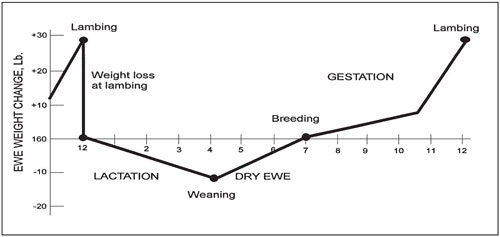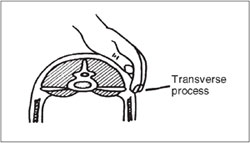by Steve LeValley* (4/13)
Quick Facts…
- Extended periods of dry weather or drought generally shorten the season sheep can graze on available forage, which reduces forage quality and can lead to a need for supplemental feeding.
- Comparisons must be based on energy, protein and water content; silage and other high moisture feeds contain a higher percentage of water, meaning a low percentage of protein and energy, even though they are highly palatable.
- Regular condition scoring—and acting on the results—will help to ensure the most efficient and economical utilization of available feed resources. Thin ewes can be separated and given extra feed. Over-fatness can be avoided by only feeding extra feed to those that need it.
Extended periods of dry weather or drought generally shorten the season sheep can graze on available forage. This reduces the forage quality greatly and consequently there is a need for supplemental feeding. Sheep require energy, protein, vitamins and minerals but these nutrients need not come from hay and some type of grain. Sheep producers may need to look at some nontraditional or alternate feeds. Feed availability, quality and relative cost per unit of feed value should determine which feeds are used.
| Table 1. Guidelines for feeding ewes. | ||
| 150 lb Ewe | TDN | Protein |
| Early Gestation | 1.7 lb | 0.3 lb |
| Late Gestation | 2.7 lb | 0.4 lb |
| Lactation | 3.7 lb | 0.8 lb |
When purchasing feeds, be careful to adjust all components of the ration to similar units and prices. For example, silage and other high moisture feeds contain a higher percentage of water. On a weight basis, these feeds have a low percentage of protein and energy, even though they are highly palatable and are good feeds to use. Comparisons must be based on energy, protein and water content. Buying feeds on an ‘as fed’ basis and comparing those to feeds in a table containing 100 percent dry matter content can be very misleading, particularly on feeds with high moisture.
Price comparisons should be carefully considered when contemplating a supplementation or feeding program. One should particularly note that hays, especially late cut hays, are low in total digestible nutrients (TDN). Straw, likewise, has a low TDN value. Feeds which are below 52% TDN will not meet energy requirements, even for maintenance, and should not be used as the sole source of energy even when they appear to be quite inexpensive. Addition of other energy and/or protein supplement, however, can make these useful alternatives to supplement ewes.
| Table 2. Guidelines for feeding compositions (as fed basis). | |
| Hay | 50% TDN |
| Grains | 75% TDN |
| Silage | 25% TDN |
| Grasses | 6-12% Protein |
| Legumes | 15% Protein |
| Grains | 9-12% Proten |
| Silage | 3% Protein |
| Grains | Low Calcium, High Phosphorus |
| Legumes | High Calcium, Medium Phosphorus |
| Grasses | Medium Calcium, Low Phosphorus |
| Silage | Low Calcium, Low Phosphorus |
When grazing resources are available, but may be unable to supply the full complement of nutrients required or are inadequate in quality, a supplementation program is recommended. This strategy entails providing enough additional nutrients to meet the animal’s needs while complementing the available grazable resources. Most frequently this is done through protein supplementation, which will enhance the energy content of the grazable resources by enhancing digestibility and by providing some digestible nutrients, as well. Frequently this is the most economical method to meet the animal’s needs. As little as .1-.2 lb of protein supplement per day will be adequate to allow the animal to meet maintenance requirements. When grazable forages are available, caution should be used in providing large proportions of the needs in the form of feed forages. This forage generally acts as a substitute rather than of supplement to the grazable forage. This is expensive and often creates a herd of lazy ewes that wait for the feed truck to come rather than grazing. Additionally, supplementation with high energy feeds such as corn or wheat should be approached cautiously. Amounts more than 1/4-1/2 lb/head/day will dramatically reduce the digestibility of the forages in the diet. Sheep are also prone to bloat on high energy rations, especially when they have been using primarily a forage based diet. Amounts of concentrates greater than 1/4-1/2 lb/head/ day should only be considered when grazable forage is not available, or forages are not economically feasible as an alternative to meet the major portion of the animal’s needs. Please note, when figuring a supplement or a total ration that a ewe needs about 2 lb dry matter per day and cannot consume more than about 4 lb dry matter per day. On an as-fed basis this amounts from 3 to 6 lbs of feed for typical dry feeds but as much as 20 lb of silage. Normally, animals cannot use silage as the total energy complement for the diet because they cannot handle that total amount of water in the diet and still maintain 4 lb dry matter intake.

Figure 1. Stages of production and estimated body weight changes.
In years when grazing feeds are limited, particular attention should be given to the amount ewes are consuming on a daily basis. If a ewe’s nutritional requirements to produce lamb and wool are not met, then she will not produce at a satisfactory level. Likewise, a ewe, when over fed, wastes limited feed resources. In certain stages of the production cycle, it may be advantageous to restrict a ewe’s intake of nutrients. Producers must first know the sheep’s nutrient requirements and the nutrient contents of the feeds that the sheep are consuming before a balanced feeding program can be calculated (see Tables 1 and 2).
Ideally, a ewe should lose five to seven percent of her body weight during lactation, recover this during the dry period and then gain weight during gestation in proportion to the weight of the fetal tissues and fluids (Figure 1).

Figure 6. Body condition three. Sheep are thrifty with evidence of limited fat deposits in fore rib, over top of shoulder, backbone, and tail head. Hipbone remains visible.
Figure 7. Body condition four. Moderate fat deposits give the sheep a smoother external appearance over the shoulder, back, rump, and fore rib. Hip bone is not visible, firm fat deposition becomes evident in brisket and around the tail head.
Figure 8. Body condition five. Sheep are extremely fat with the excess detectable over the shoulder, backbone, rump, and fore rib. Excess fat deposits in brisket, flank, and tail head regions lack firmess. Sheep appear uncomfortable and reluctant to move about. Quality fleeces are generally found. |

Figure 2. Feel for the tips of the transverse processes.
Figure 3. Body condition zero. Sheep is extremely thin, unthrify and weak. Skeletal features very prominent, e.g. backbone, shoulder blades and ribs. Wasted muscle tissue evident. Eye socket is prominent and sunken. May be humped back and isolates self from flock.
Figure 4. Body condition one. Sheep is extremely thin, unthrifty but agile. Skeletal features are prominent with no fat cover. No apparent muscle tissue degeneration. Has strength to remain with the flock.
Figure 5. Body condition two. Sheep is thin but strong and thrifty with no apparent muscle structure wasting. No evident fat cover over the backbone, rump and ribs, but skeletal features do not protrude. |
One of the best ways to determine how much a ewe should be fed is by monitoring her changes in condition. By condition scoring and using that information in the feeding program, available feed resources can be stretched and yet provide adequate nutrition for satisfactory production. Condition scoring is a system of classifying breeding animals by differences in relative body fatness. It permits the sheep producer to identify, record and adjust the feeding program to those sheep that are thin, in average flesh or extremely fat. Thin or fat ewes can be sorted-off and fed accordingly. Also, potential need for major changes in the feeding program can be determined. Body condition scoring is relatively easy to do and requires no specific equipment except a sorting chute and maybe some chalk. To be most effective, condition scoring should be a ‘hands-on’ appraisal. A hands-on condition score permits a truer assessment of a sheep’s condition, which, during critical production periods, (last four to six weeks of pregnancy) is often hidden by fleece growth. Scoring should be based on the degree of muscling and fat deposition over and around the vertebrae in the loin region (Figure 2). Usually sheep are condition scored from one to five with one being extremely thin, five being extremely fat, and three being average (Figures 3, 4 and 5). Typically, about 70-80 percent of sheep in a flock will fall within two scores with over 90 percent of sheep in a flock within three scores (e.g., scores two, three and four).
Although limited research exists, a great deal of practical evidence suggests that extreme condition scores of one and maybe two, should be avoided because of decreased performance and livability. Similarly, the extremes of four and five should be avoided because of problems in conception and lambing, because economics discourages the extremes of four and five. Ewes with scores of four and five or one and two become strong candidates for pregnancy toxemia. Ideally, at breeding, ewes should have a condition score of between two+ and three+ and rams around three+. This body condition should be maintained for the first 30 days post-breeding. During mid-gestation, some loss of weight and condition is allowable at the three and four score levels. However, this weight loss should not exceed five percent of the mature ewe’s weight at a condition score of three or three+. During late gestation, ewes should have sufficient body reserves to maintain the growth of the lambs and initiate optimum milk production. A body condition score of two+ to three+ is desirable four to six weeks prior to lambing. At lambing, ewes should have a condition score of three +. In an experiment conducted at Montana State University, over 50 percent of the lambs born to ewes with condition scores of two or less died or had to be bummed. When condition scores were around three, the number of lambs dying or being bummed was significantly reduced. Regular condition scoring, and acting on the results, will help to ensure the most efficient and economical utilization of available feed resources. Thin ewes (condition scores one and two) can be separated and given extra feed. Over-fatness can be avoided by only feeding extra feed to those that need it. Ewe’s requirements for feed can be more accurately determined by assessing the relative body condition. Thin ewes will require more nutrients than fat ewes and can be fed accordingly when identified and fed separately.
Summary and Conclusion
The requirement for a ewe for feed can be more accurately determined by assessing the relative body condition. Thin ewes will require more nutrients than fat ewes and can be fed accordingly when identified and fed separately. When pastures dry out or run out of grass effective programs must be designed to meet the animal’s nutrient requirements. Remember, generally ewes on a low quality grazing resource respond well to additional protein; too much concentrate means poor forage usage.
*Steve LeValley, Colorado State University Extension sheep and wool specialist, animal sciences. 4/13,.
Colorado State University, U.S. Department of Agriculture and Colorado counties cooperating. Extension programs are available to all without discrimination. No endorsement of products mentioned is intended nor is criticism implied of products not mentioned.
Go to top of this page.










